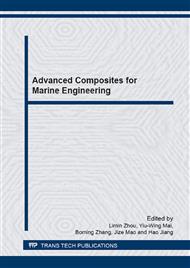p.63
p.72
p.78
p.85
p.94
p.102
p.109
p.116
p.127
A Computational Method of Residual Stress Calculation for Incremental Hole-Drilling Method Utilized Composite Materials
Abstract:
In this work, a computational method dedicates to realize the residual stress calculation for multi depths with incremental hole-drilling method. An optimized finite element model is determined with proper size compared to the experiment. By invaliding the mechanical properties of the drilled section in the model, the step-by-step drilling procedure is simulated for incremental hole-drilling method. As the practical application of such computational method, a bulk metallic glass (BMG) sample being mechanically treated by severe plastic process is used to demonstrate the distribution of residual stresses along thickness direction.
Info:
Periodical:
Pages:
94-101
Citation:
Online since:
March 2015
Authors:
Price:
Сopyright:
© 2015 Trans Tech Publications Ltd. All Rights Reserved
Share:
Citation:


